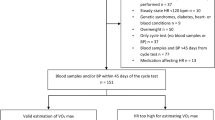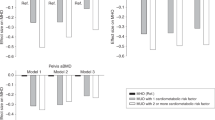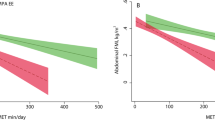Abstract
Objective: To examine the influence of cardiorespiratory fitness on total and truncal fatness in children. It was hypothesised that high cardiorespiratory fitness would result in lower total and central obesity.
Design: Observational cohort study.
Setting: Primary and secondary schools in Athens, Greece.
Subjects: A total of 1362 healthy children aged 6–13 y (742 boys and 620 girls).
Methods: Anthropometric data (height, body mass, four skinfolds thickness) were collected and per cent body fat was calculated. Body mass index (BMI) sex- and age-specific cutoff points were used for overweight and obesity definition and children were placed in two groups: overweight/obese and nonoverweight. Cardiorespiratory fitness (CRF) was assessed with the endurance shuttle-run test. Participants were grouped into high (upper two quintiles) and low (lower two quintiles) CRF based on age and sex distributions. T-test and Mann–Whitney test were used for comparisons between fit and unfit children within each BMI category.
Results: Sum of skinfolds, subscapular and truncal skinfold thickness, BMI and per cent body fat were lower in overweight and obese youths with high CRF in comparison with youths at the same BMI category with low CRF (P<0.01). The beneficial effect of high CRF was also presented in nonoverweight children (P<0.01). The influence of CRF on body composition remained even after correcting body fatness for BMI.
Conclusions: Central and total obesity were lower in overweight and obese children with high CRF. This is the first study to show that a high CRF may reduce the hazards of obesity in children.
Sponsorship: None.
This is a preview of subscription content, access via your institution
Access options
Subscribe to this journal
Receive 12 print issues and online access
$259.00 per year
only $21.58 per issue
Buy this article
- Purchase on Springer Link
- Instant access to full article PDF
Prices may be subject to local taxes which are calculated during checkout


Similar content being viewed by others
References
Bigaard J, Tjonneland A, Thomsen BL, Overvad K, Heitmann BL & Sorensen TI (2003): Waist circumference, BMI, smoking, and mortality in middle-aged men and women. Obes. Res. 11, 895–903.
Blair SN, Kohl HW, Paffenbarger RS, Clark DG, Cooper KH & Gibbons LW (1989): Physical fitness and all-cause mortality: a prospective study of healthy men and women. JAMA 262, 2395–2401.
Bland J & Altman D (1986): Statistical methods for assessing agreement between two methods of clinical measurement. Lancet 1, 307–310.
Cole TJ, Bellizi C, Flegal KM & Dietz WH (2000): Establishing a standard definition for child overweight and obesity worlwide: international survey. BMJ 320, 1240–1243.
Council of Europe, Commitee for the Development of Sport (1993): EUROFIT: Handbook for the EUROFIT Tests of Physical Fitness. Strasbourg, France: Council of Europe.
Duncan GE, Perri MG, Theriaque DW, Hutson AD, Eckel RH & Stacpoole PW (2003): Exercise training, without weight loss, increases insulin sensitivity and postheparin plasma lipase activity in previously sedentary adults. Diabetes Care 26, 557–562.
Freedman DS, Srinivasan SR, Harsha DW, Webber LS & Berenson GS (1989): Relation of body fat patterning to lipid and lipoprotein concentrations in children and adolescents: the Bogalusa Heart Study. Am. J. Clin. Nutr. 50, 930–939.
Freedman DS, Serdula MK, Srinivasan SR & Berenson GS (1999): Relation of circumferences and skinfold thicknesses to lipid and insulin concentrations in children and adolescents: the Bogalusa Heart Study. Am. J. Clin. Nutr. 69, 308–317.
Goodpaster BH, Katsiaras A & Kelley DE (2003): Enhanced fat oxidation through physical activity is associated with improvements in insulin sensitivity in obesity. Diabetes 52, 2191–2197.
Goran MI, Kaskoun M & Shuman WP (1995): Intra-abdominal adipose tissue in young children. Int. J. Obes. Relat. Metab. Disord. 19, 279–283.
Heyward VH & Stolarczyk LM (1996): Applied Body Composition Assessment. Champaign, IL: Human Kinetics.
Janssen I, Katzmarzyk PT & Ross R (2002): Body mass index, waist circumference, and health risk: evidence in support of current National Institutes of Health guidelines. Arch. Intern. Med. 162, 2074–2079.
Lakka HM, Lakka TA, Tuomilehto J & Salomen JT (2002): Abdominal obesity is associated with increased risk of acute coronary events in men. Eur. Heart J. 23, 687–689.
Lee CD, Blair SN & Jackson AS (1999): Cardiorespiratory fitness, body composition, and all-cause and cardiovascular disease mortality in men. Am. J. Clin. Nutr. 69, 373–380.
Leger LA & Lambert J (1982): A maximal multistage 20-m shuttle run test to predict VO2max . Eur. J. Appl. Physiol. 49, 1–12.
Lobstein T & Frelut ML (2003): Prevalence of overweight among children in Europe. Obes. Rev. 4, 195–200.
Maffeis C, Corciulo N, Livieri C, Rabbone I, Trifiro G, Falorni A, Guerraggio L, Peverelli P, Cuccarolo G, Bergamaschi G, Di Pietro M & Grezzani A (2003): Waist circumference as a predictor of cardiovascular and metabolic risk factors in obese girls. Eur. J. Clin. Nutr. 57, 566–572.
McCarthy HD, Ellis SM & Cole TJ (2003): Central overweight and obesity in British youth aged 11–16 years: cross sectional surveys of waist circumference. BMJ 326, 624–627.
Mechelen Van W, Hlobil H & Kemper HCG (1986): Validation of two running tests as estimates of maximal aerobic power in children. Eur. J. Appl. Physiol. 55, 503–506.
Mourier A, Gautier JF, De Kerviler E, Bigard AX, Villette JM, Garnier JP, Duvallet A, Guezennec CY & Cathelineau G (1997): Mobilization of visceral adipose tissue related to the improvement in insulin sensitivity in response to physical training in NIDDM. Effects of branched-chain amino acid supplements. Diabetes Care 20, 385–391.
Ross R & Katzmarzyk PT (2003): Cardiorespiratory fitness is associated with diminished total and abdominal obesity independent of body mass index. Int. J. Obes. Relat. Metab. Disord. 27, 204–210.
Ross R, Dagnone D, Jones PJH, Smith H, Paddags A, Hudson R & Janssen I (2000): Reduction in obesity and related comorbid conditions after diet-induced weight loss or exercise-induced weight loss in men. Ann. Intern. Med. 133, 92–103.
Savva SC, Tornaritis M, Savva ME, Kourides Y, Panagi A, Silikiotou N, Georgiou C & Kafatos A (2000): Waist circumference and waist-to-hip ratio are better predictors of cardiovascular disease risk factors in children than body mass index. Int. J. Obes. Relat. Metab. Disord. 24, 1453–1458.
Slaughter MH, Lohman TG, Boileau RA, Horswill CA, Stillman RJ, Van Loan MB & Bemben DA (1988): Skinfold equations for estimation of body fatness in children and youth. Hum. Biol. 60, 709–723.
Tell GS & Vellar OD (1988): Physical fitness, physical activity, and cardiovascular disease risk factors in adolescents: the Oslo Youth Study. Prev. Med. 17, 12–24.
Ulijaszek SJ & Kerr DA (1999): Anthropometric measurement error and the assessment of nutritional status. Br. J. Nutr. 82, 165–177.
Wang Y, Monteiro C & Popkin BM (2002): Trends of obesity and underweight in older children and adolescents in the United States, Brazil, China and Russia. Am. J. Clin. Nutr. 75, 971–977.
Author information
Authors and Affiliations
Corresponding author
Additional information
Guarantors: GP Nassis and LS Sidossis.
Contributors: GPN and LSS developed the original idea. GPN and GP collected the data and performed the analysis. GPN drafted the paper; LSS and GP contributed to the interpretation of data and to the writing of the paper.
Rights and permissions
About this article
Cite this article
Nassis, G., Psarra, G. & Sidossis, L. Central and total adiposity are lower in overweight and obese children with high cardiorespiratory fitness. Eur J Clin Nutr 59, 137–141 (2005). https://doi.org/10.1038/sj.ejcn.1602061
Received:
Revised:
Accepted:
Published:
Issue Date:
DOI: https://doi.org/10.1038/sj.ejcn.1602061
Keywords
This article is cited by
-
Performance and reproducibility on shuttle run test between obese and non-obese children: a cross-sectional study
BMC Pediatrics (2017)
-
Physical fitness reference standards in European children: the IDEFICS study
International Journal of Obesity (2014)
-
Physical fitness in childhood and adolescence: a powerful marker of health
International Journal of Obesity (2008)
-
Cardiorespiratory fitness and abdominal adiposity in youth
European Journal of Clinical Nutrition (2007)
-
Definitions of childhood obesity: current practice
European Journal of Clinical Nutrition (2006)



